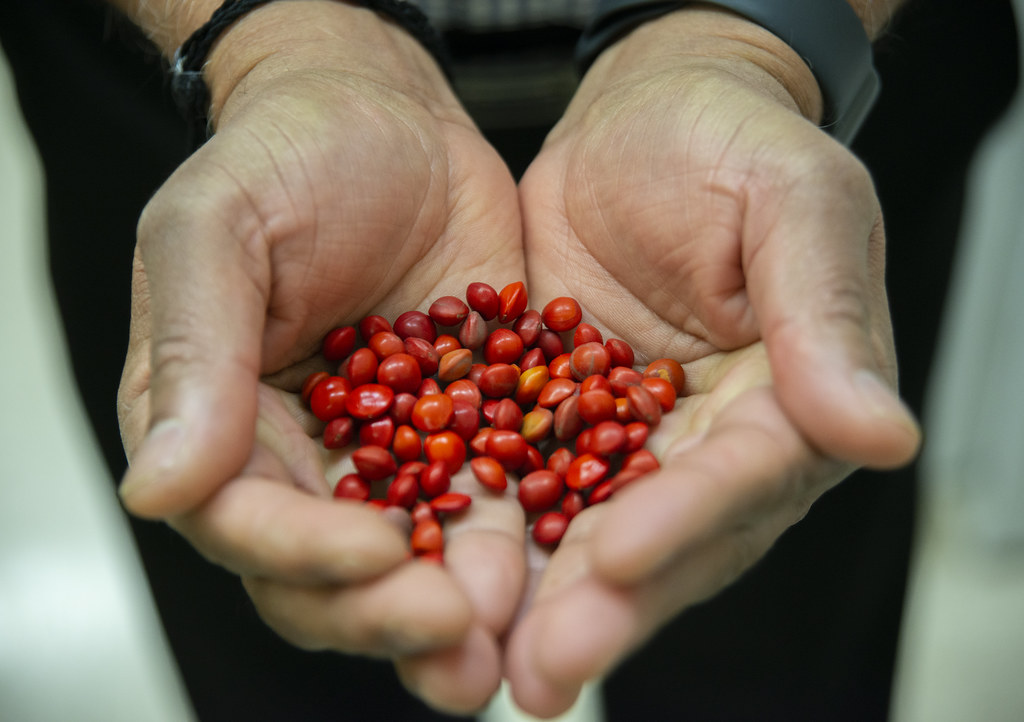News
Protein or Poison? Research into seed composition shows potential uses as protein source or insecticide

By Cara Penquite | Bond LSC
An energetic and fulfilling day starts with a spread of healthy meals, and many people rely on nutrition labels to meet their daily quota of vitamins and nutrients. But how did scientists measure the Vitamin C in an orange or the protein content in peanuts for the label?
Finding out what is in food we eat starts with scientists like Hari Krishnan, a USDA-ARS molecular biologist and MU adjunct professor of plant science and technology. Krishnan calculated the type and degree of nutrients packed into seeds from red bead trees with the help of the Advanced Light Microscopy Core in Bond Life Sciences Center.
“We are highly dependent on the food that we eat,” Krishnan said. “Anything we can do in order to either improve nutrition or quality or finding alternative sources of food is very useful.”
Commonly known for its pods of seeds as bright as red M&M’s, the red bead tree is known as Adenanthera pavonina in research communities. Krishnan took an interest in A. pavonina seeds — turning away from his usual soybean research — to see if they could be a potential alternative protein source in developing countries. He quickly found a different, unusual characteristic.
“I’ve never seen a seed have such a high content of trypsin inhibitor,” Krishnan said.
Our bodies make trypsin to break down protein in our intestines, but trypsin inhibitors block the enzyme from its job of protein digestion. That makes it hard for us to benefit from nutritious proteins in the seeds. Although many Asian and African communities already incorporate A. Pavonina seeds in their diet, its unusual amount of trypsin inhibitors limits nutritional benefits.
“Soybeans have probably less than five percent of the entire seed protein made of trypsin,” Krishnan said. “This particular legume is 20 to 25 percent, which is fairly very high.”
Krishnan turned to Alexander Jurkevich, associate director of MU’s Advanced Light Microscopy Core, to find out where in the plant’s cells the trypsin inhibitors were located. Jurkevich and Krishnan used glowing molecules to mark the trypsin inhibitors and see where they are stored in the cells.

Tagging protein here starts with an antibody. The first antibody acts like one side of a strip of velcro that can attach to a second antibody that also carries a molecule of a fluorescent dye. Through the double antibody system, the glowing, fluorescent flag attaches to show scientists which parts of the cell have trypsin inhibitors.
While Krishnan developed the antibody, Jurkevich used his expertise in light microscopy to take images of the glowing cells.
“This cooperation is very important, because modern research technologies are very complex and a single person cannot learn and excel at all techniques available in life sciences,” Jurkevich said.
Understanding the amount and locations of trypsin inhibitors, Krishnan looked to reduce inhibitors so the seeds would be more nutritious for humans.
Roasting or boiling the seeds breaks down the trypsin inhibitors, but Krishnan warns that it may break down other essential amino acids as well. In his work with soybeans, Krishnan looks for a way to grow plants without trypsin inhibitors at all.
“We were able to find some [soybean] mutants, which have lower levels of this trypsin inhibitor,” Krishnan said.
Natural mutants with lower levels of trypsin inhibitors could be cultivated on a larger scale to produce seeds that are easier for humans to digest.
Since trypsin inhibitors are not ideal for consumption, Krishnan decided to think outside of the box. He turned to USDA-ARS research scientist and entomologist Adriano Pereira to find another use for the seeds.
Pereira tested the seed proteins as an insecticide against corn rootworm larvae and found that it stunted larval growth but did not necessarily cause mortality. While it is still early in this research, there may be some insecticidal properties from the seed.
“It’s something that has to be investigated to make sure […], but we assume that since it is a trypsin inhibitor it could be inhibiting on some level the trypsin during the growth of the larvae,” Pereira said.
As Krishnan’s first look into A. pavonina seeds, the research opened many new questions yet to be answered, but he plans to continue investigating the role of trypsin inhibitors in soybeans and other plant protein sources.
“[Research] is a never-ending investigation, and one thing leads to another. It’s always interesting,” Krishnan said. “I come to the lab everyday thinking of what I’m going to end up doing today.”
Hari Krishnan is a joint researcher molecular biologist with the USDA-ARS and adjunct faculty member in Mizzou’s College of Agriculture, Food and Natural Resources. This research published online in the journal Food Chemistry: X on Feb. 12, 2022 titled “Adenanthera pavonina, a potential plant-based protein resource: Seed protein composition and immunohistochemical localization of trypsin inhibitors.”
The Advanced Light Microscopy Core provides technical imaging expertise to researchers who need state-of-the-art imaging for their experiments. That includes confocal, super-resolution, digital light-sheet and widefield microscopes, image analysis and processing and sample preparation.